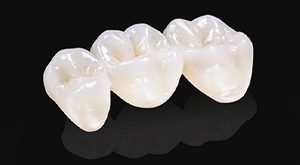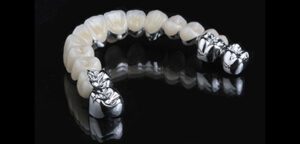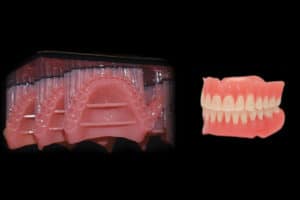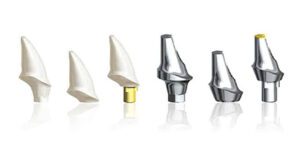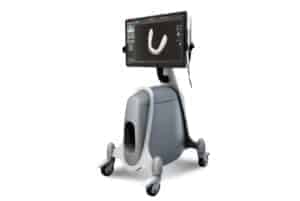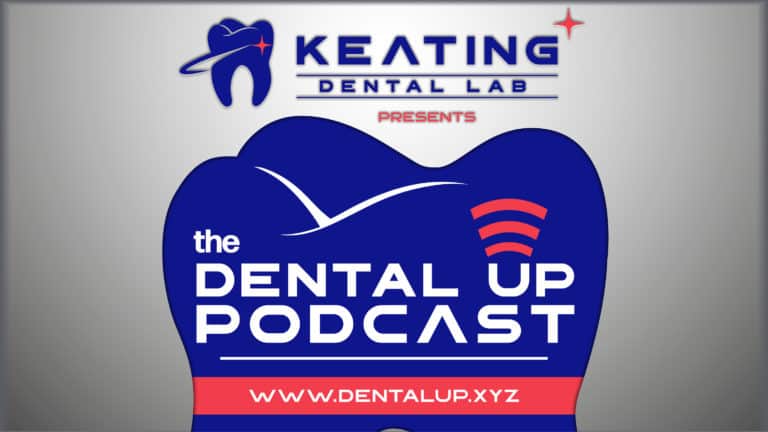With the complexity of denture cases, getting the desired result might be a challenge to many dentists. Jack Edwards CDT, MDT shares his vast knowledge of removables to create the perfect denture restoration and stresses the importance of doctor/laboratory communication and planning.
Full Transcription:
Shaun Keating: Hey everybody, welcome to this week’s Dental Up podcast. This is Shaun Keating here. I’m with Jack Edwards. He’s our director of eduction here. Real excited to have Jack onboard with us today.
Jack Edwards: Happy to be here.
Shaun Keating: Good job, Jack. I’d like to start off talking about sports and stuff. It’s weird. I’d rather just do sports and not really talk about dentistry myself sometimes. Big thing around here is the Lakers. I’m a big Lakers fan for years. Last few years [00:00:30] it’s been pretty tough, cringe worth watching them. It’s just been horrible watching Kobe’s career wind down and him just shooting up a gazillion shots and not being quite the player he was. It was neat to see him leave actually last year to get us back in to see what we’re all about. We’ve got a good crew of young guys, pretty neat guys, Randle, D’Angelo Russell, the Ingram kid, but just a neat core group, [00:01:00] Nance Jr. We’re excited about that. We probably need a really good big man and a couple other guys. We’ve got Luke Walton in this year, which is a great young coach. I think everyone’s really going to rebound around him.
Jim Buss, one of the owner’s son that died, Dr. Buss died a few years back, and his daughter, Jeanie, runs the team, and then there’s six siblings that they all own it. That’s neat how he set it up. Jeanie’s in charge and she’s let her brother [00:01:30] run basketball operations as the president for the last three, four years, and they haven’t really done it. Big thing came out with Magic Johnson becoming the new president. That’s pretty cool as long as he’s not just a cheerleader, that he’ll do more than just be the face of … He needs to get in there and really make a difference. Exciting in Laker Nation to have Magic back.
Then we’ve got this new kid, Rob Pelinka, who’s taking over as the general manager. [00:02:00] It was Mitch Kupchak, since ’94 he’s been a Laker, and he’s been there for a long time. They also got rid of Bob Black who’s been there for 35 years, and he’s been the spokesman. They cleaned house and they’re going to bring in this Pelinka kid. He’s an agent. He’s an agent for Kobe, used to be Kobe’s agent and some other big guys. That’s what they’re going to. You’ve really got to know about contracts and how to work in the NBA and stuff to make things happen, [00:02:30] to find talent. I don’t even know the guy’s name over at Golden State Warriors, he’s really made a difference there, the same kind of scenario where this guy didn’t really have any basketball general manager experience but he came in. He’s doing a great job with the Warriors.
This Pelinka kid looks like a Rob Lowe type guy. It’s like, what’s this? He’s a younger guy. I think he’s in his mid 40s. It’s exciting to get back to Laker … It was such [00:03:00] a big thing for so many years, and the last four, five, six years, I hardly even go out to Staples Center anymore. It’s tough. We’re excited about Magic. Also, March Madness coming up. We’ve got UCLA.
Jack Edwards: The Bruins.
Shaun Keating: I’m really excited to see the Bruins get back into dominance like it was back in their early days. They’ve got this Lonzo Ball kid that the dad’s kind of a freak, weird dad. We all love our children, [00:03:30] so it’s something with this Ball kid. He has two younger brothers. They go to Chino Hills or whatever, and a real big phenomenon here in high school basketball, these brothers. The dad, he’s one and done. This kid’s a freshman, makes a difference, does a lot of assists, pretty awesome ballplayer. His dad’s comparing him to Steph Curry and saying he could be better than Steph, if they switched teams, he would do better. It’s like, come on, dude. We love our children. My boys, I thought they were going to be the next Walter Payton, [00:04:00] but when you’re five foot nothing, 100 and nothing, you ain’t going to be no NFL running back. We love our children. We think they’re going to be in the big games and all that, but at the end of the day, 99.99% of all high school athletes don’t go on to that pro level.
Jack Edwards: Unfortunately, that’s very true.
Shaun Keating: That’s true.
Jack Edwards: Very true.
Shaun Keating: Don’t you have your grandson, he’s a swimmer or something?
Jack Edwards: My grandson. My grandson, yes.
Shaun Keating: Tell me a little [00:04:30] bit about that.
Jack Edwards: He’s 12 years old, and he is qualifying for the Junior Olympics.
Shaun Keating: You’re kidding.
Jack Edwards: He is qualified in five events, and I believe the sixth one was about two weeks ago.
Shaun Keating: Really?
Jack Edwards: He actually medaled in the backstroke. With that, we’re all excited for him.
Shaun Keating: That’s so cool.
Jack Edwards: He’s doing phenomenal.
Shaun Keating: He’s going to be our next Michael Phelps?
Jack Edwards: Well, you would think.
Shaun Keating: We hope.
Jack Edwards: You would think. He’s already got a foot. His feet [00:05:00] are like flippers.
Shaun Keating: You’re kidding.
Jack Edwards: Yeah, he’s doing very well.
Shaun Keating: That’s a big thing for collegiate, to go to college, to get a scholarship.
Jack Edwards: Very much so.
Shaun Keating: If that can get your ticket in there, that saves your whoever a lot of money, or grandpa. It’s a neat thing. I always told my kids, “The only way you’re going to go college, you get a scholarship.” That was a little joke there.
Jack Edwards: My main objective when I go to be with him other [00:05:30] than to cheering him on is to photograph him. I do have a couple of samples that I bring, if I may show those.
Shaun Keating: Yeah, absolutely. Geez, he looks like a man. He doesn’t look like a 12 year-old.
Jack Edwards: Here he is doing the backstroke.
Shaun Keating: The guy’s got a full goatee. No, just kidding.
Jack Edwards: Here he is doing the butterfly.
Shaun Keating: Dude, he’s got a big long arm span there.
Jack Edwards: Isn’t that? Isn’t that? We’re very proud.
Shaun Keating: You can’t really have those T. Rex arms to be a swimmer.
Jack Edwards: No, no, no. No, not at [00:06:00] all.
Shaun Keating: That’s awesome, dude. That’s great. Hey, I hope he goes all the way, and I hope we’re watching him on TV someday. Good job on that.
Jack Edwards: Appreciate that, thank you.
Shaun Keating: I heard something too … We’ll get into the dental thing here. I heard NASA just discovered seven planets out there, and that’s just the weirdest thing in the world. They found seven new planets, and they think there’s life form and stuff.
Jack Edwards: That’s what I’ve heard. This is what I’ve heard, yes.
Shaun Keating: It makes you want to pray to God [00:06:30] more and that, I think. If there’s people out there living on these planets, and it’s similar to Earth, I guess, it’s the whole light years of how quick … I don’t know how they do it. It’s a pretty amazing thing after all these years we’ve been on Earth, and millions of years, this and that. Then you think about us, the United States, a couple hundred years old basically. The new things coming out, it’s 40 light years away [00:07:00] from what I hear. I don’t know a light year, I’m not a real smart guy when it comes to that. Man, to discover seven new planets that are similar to Earth, that they pretty much show there’s life on it. It’s weird. It’s scary what we really don’t know what’s out there. That’s why you’ve got to have faith maybe. That’s what I do, go to bed and say, “Please, Lord, help us.”
Okay, enough of that. Let’s talk a little dental. That’s what this is all [00:07:30] about. Jack, I’ve known you for over 30 years, man. That ages us a little bit.
Jack Edwards: It does, it does.
Shaun Keating: You’ve been doing this forever. You’re one of, I think, only 700 master dental technicians that are actually masters in the United States. I think you’re fellow.
Jack Edwards: It’s a fellow, a fellowship, yes.
Shaun Keating: A fellowship. There’s only 40 of you?
Jack Edwards: 40 of us.
Shaun Keating: 40 of you. I’m just so thankful that you’re here with us because you’ve pretty much retired. I talked you out to [00:08:00] come back because I’m a fixed guy. You’ve got fixed stuff. For the people out there, a lot of people know, but fixed is it’s fixed permanently in your mouth. Your specialty, although you do everything, but your specialty really is removable. With us here, I’ve always been a fixed lab, but several years back I had to start a removal department so I could become full service because a lot of my dentists, they would use me for my fixed work, they’d use me for the crown or bridge. [00:08:30] Then when I had removable, a lot of times you’ll go 6 through 11 and beyond that, we have to do a semi-precision partial, put a PD or an ERA, and then you do that.
So many of my doctors would say, “Shaun, I hate to send you the fixed work, and then I’ve got to send it off to a removable lab to do it.” Then when your removable and fixed don’t work together, it’s a freaking nightmare. It’s even a nightmare when we work together that if we’re not on the same page … [00:09:00] Removable brings me a lot of headaches. It brought me a lot of gray hair back in the day because I don’t like doing it, to tell you the truth, but it’s what we have to do. A lot of people are dentures. We do upper dentures, we do lower dentures, we do partials. We do a lot of implant stuff. There’s a lot of the four on one stuff.
Right now, we could talk for an hour on that or more, but I want to go through some things and just let you talk a little bit about say just on dentures, when a case comes [00:09:30] in, how we go through and do the things. Also we’ll get through and just what a dentist can do to help us have more predictable outcomes on the removable type situations, getting impressions on ridges and getting proper impressions that are accurate. Let’s go ahead and talk a little bit about our denture process when it comes in and how we go about it.
Jack Edwards: Certainly will. Of course when a case comes in, sent in by a dentist, usually it’s with impressions, [00:10:00] usually an upper and lower if we’re doing a full set. There might be a bite involved in there. Hopefully there’s a face bow, which we can then utilize to set up the case on an articulator. With that starts our first QC. We are actually QC. This is very important that we communicate very closely with our clients as they send in the work so that we have a better understanding of exactly what they’re looking for in a case. With that, [00:10:30] we’ll pour them up. We’ll then QC the models, the casts, to see if they meet the criteria that we need to have to do a good successful case.
Shaun Keating: What’s the problem with a cast? Do we get voids or something, maybe certain ridge, alveolar ridge?
Jack Edwards: There’s a lot of that. There’s a lot of that. We actually need, if we’re doing a maxilla, we need to have the palate, we need to have the phalanges, all the [00:11:00] way down to the vestibules, as well as the hamular notches in the posterior. With that, it starts us off in the right direction. We’re able to then create a bite rim that is more to the standards of that. With the lower we do the same thing. We have to have the retromolar pads in the posteriors as well as the phalanges [00:11:30] and definitely with the tongue out of position, if at all possible, as deep phalanges as we can get into the vestibules of the lower ridge. With that being said, those are the first things that we need to do.
Shaun Keating: Real quick on that though. The tongue is such a beast to get that.
Jack Edwards: Yes.
Shaun Keating: What do you do, you almost hold it with some hemostats or pull apart?
Jack Edwards: Believe it or not, I have seen that. I don’t recommend that.
Shaun Keating: I’ve got a wild [00:12:00] tongue. When I’m in there, it’s like [inaudible 00:12:03].
Jack Edwards: I’ve seen just about everything being also an in house technician too, so I have that full extension to that aspect. The tongue, usually we ask the patient to raise the tongue up towards the top of their mouth. That’s right. With that, it pretty well clears it out. Then we can make sure that we get the impression material to get inside of that area so that we have a full impression of that complete arch. This [00:12:30] is very, very key. It’s not just taking a horseshoe impression. It’s nothing like crown and bridge. This is removable, and this is what I’m trying to … We work with our clients because phone calls are very, very important.
Shaun Keating: Yeah, absolutely.
Jack Edwards: That is the key. We have to have collaboration and communication. We’ve got to create a rapport with our clients. We have the manager, Jim, and we have [00:13:00] one of his assistants is Brian. Both of these gentlemen are on the telephone all the time.
Shaun Keating: Absolutely.
Jack Edwards: We actually use probably more phone calls and more phone work than the crown and bridge guys do.
Shaun Keating: Oh, I know, you guys do.
Jack Edwards: These cases are not that easy. One would think that they’re easy. No, it’s not that case. These are more complicated. The kind of work that I do dealing with implants and All-on-4 kind of scenarios, they take a lot [00:13:30] of time and precision work that we have to do. That’s why it’s part of my other job there other than …
Shaun Keating: Yeah, I know.
Jack Edwards: … being a director of education.
Shaun Keating: Yeah, you put a lot of fires out and you’re on the phones a lot. It just all gets back to the darn impression. To go beyond that, yeah, we have a lot of things we could do to work on things there, but the impression itself, it’s the foundation. If we can’t get that … What do you find you like best, old school [inaudible 00:13:58] that just flows in better [00:14:00] or what?
Jack Edwards: Actually, I still like the polyvinyl siloxane. My preference is a two-stage technique. You could actually almost use a lab putty or a very heavy body material in a standard stock tray, take that first, remove it, then we can cut out, if there’s teeth in there, we can cut it out. I’ll say for an immediate we can cut out the areas where the teeth are and everything. Then we re-inject a light bodied impression material, [00:14:30] replace it, and that gets everywhere. Then we let that set up. As we pull it out, we have a much, much better, accurate impression.
Shaun Keating: That’s so cool. We should do a little video on that even here because how many of our guys actually do that where they cut it out, maybe 10%, 20% or more? It’s just hard to say probably. If we could get the right technique that will give you 95% to 100% accurate results, I think they want that in a way.
Jack Edwards: Eliminate [00:15:00] those poles that we see, and the drags, and the distortion in the cases that we’re dealing with. Even though this is just removable, but we want to be very precisely.
Shaun Keating: Absolutely.
Jack Edwards: We want good adhesion, mucostatic adhesion.
Shaun Keating: You want a fit. We always say socks on a rooster.
Jack Edwards: No, no.
Shaun Keating: We don’t want that. We don’t want them flopping around where they have to still … Do they still use that gunk they put in there for adhesion? Remember that? What was that called? What was that stuff called?
Jack Edwards: Yes, they still-
Shaun Keating: [00:15:30] Supergrip, or what is it called?
Jack Edwards: They’ve got a lot of that. You’re talking about all the ones that you can buy?
Shaun Keating: On TV back in the ’70s. What was that called?
Jack Edwards: Yes, you can buy at the drugstore and all that stuff.
Shaun Keating: What’s the name of that stuff?
Jack Edwards: Poligrip.
Shaun Keating: Poligrip.
Jack Edwards: Poligrip.
Shaun Keating: He had the Poligrip. There are things in the side. “Honey,” imagine the guy waking up in bed. “Hey, get your juice out. Okay.” Jesus.
Jack Edwards: Unfortunately, that’s the stigma that we have to deal [00:16:00] with.
Shaun Keating: Yeah, but nowadays with the right retention though … Just like a doctor when he preps a prep, if he gets the right angles, you almost don’t need cement. The friction, everything holds it. Especially if you can get a denture that has got all your borders and boundaries all in the impression, these things are going to lock and load in there.
Jack Edwards: All the time.
Shaun Keating: All the time.
Jack Edwards: All the time.
Shaun Keating: So much better.
Jack Edwards: All the time.
Shaun Keating: You wonder why patients complain about this and that. It’s probably from the dentist not giving us a super accurate impression that I can come in and … We’re [00:16:30] sucking these things down a vacuum. It’s what we get is what it’s going to be made to. If we’re having gaps and this and that, it’s not going to be as retentive as it can be. That’s a whole thing, too. We always said let’s sink an implant here and here, and then lock and load that denture, and it’s still not fitting. You really need that awesome impression. It’s great if you can sink a couple implants to lock that denture in, but a lot of people can’t afford that. A lot of people can’t do that. [00:17:00] If that dentist could give them a smoking hot impression for us, our dentures are really good, I think …
Jack Edwards: Very much so.
Shaun Keating: … when we’re doing them right and when we’re getting the right stuff in. Go ahead, I’ll shut up.
Jack Edwards: All in all, what I’m looking for in our relationship with our clients is that the client, we need for them to provide us with a clinical treatment plan. We don’t necessarily need to know their medical history, their dental history, [00:17:30] or their financial. Mainly it might involved the patient’s wants and needs, what the doctor is looking for in the case, and we need to know actually, if it has to do with anything with implants, we need to have a surgeon’s letter that tells us in detail what the surgeon put into the mouth, what the name of the implant is, what the style of the implant is, the size, everything, because from there we can help the restorative dentist build [00:18:00] the case. We can help them look at the parts that we would need to have because a lot of times we get the case coming in that is only at the fixture level.
We’re restorative. We work from the tissue up. Anything that’s below, we’re at a loss here a little bit because we can get the parts and we can get the size, and blah blah blah, but we can’t put those in. We need the restorative dentist to put [00:18:30] those abutments in, and that’s where we restore, from the abutment level up.
Shaun Keating: Are we getting that with most of our guys or a lot of times not?
Jack Edwards: A lot of times not. In a sense, when we get a case, it’s already in the middle of the case. What happened to stage one, the very beginning? For an example, here’s a case that I’ve done an immediate where I’ve done model surgery, replaced all the teeth, and then [00:19:00] I’ll be processing this and this will eventually go in … I’ll actually make a surgical guide from here, and this will all go in toward implant placement. This will actually go to the middle of the series, the workflow, in the conversion. Then the surgeon will utilize this for the guides, setting everything, placing the abutments, and then we should get it back at that time. A lot of our cases that come in never got to that level. They’ve already [00:19:30] started the case, the implants are in, and now we’re in the middle of this workflow. I usually at this time have to say … Sometimes there’s not even teeth set, so we’ve got to go back and start-
Shaun Keating: It’s a crapshoot, totally.
Jack Edwards: We have to start over again, start setting up teeth. We have to have a blueprint. We have to have our foundation.
Shaun Keating: Is that where we set the two teeth and bite block and send it to them and say, “Give me something. Show me where their midline or their nose in, and let’s go off the face.”
Jack Edwards: Shaun, it’s a lot [00:20:00] of that.
Shaun Keating: I know.
Jack Edwards: It’s a lot of that. I’ve been very, very fortunate to have been an in house technologist, and also I work with a few dentists that actually invite me to their practice and I work with them and the patient. Now they actually have the representative of a laboratory there talking about the technical aspects of the case. When we bring the whole team together …
Shaun Keating: It just goes so great.
Jack Edwards: … it’s phenomenal.
Shaun Keating: I do that just in fixed with doctors. When we do it from [00:20:30] the beginning and we get stump shades, and we do the temporaries, or the custom wax stumps, when we do it right by the book, it’s just a bitching feeling, man. It just goes so good.
Jack Edwards: Very much so.
Shaun Keating: I just did a case. I have a friend that’s been my friend since junior high school, even sixth grade on up. The dude’s teeth are always messed up forever. All these years I would say, “Mark, I’m going to make you these teeth.” We did it in Monday. We flew him out on Monday, but we already had his study models, we already looked [00:21:00] at them, we had all the x-rays. My doctor out here, I sent him out here because I wanted my doctor to do it for him. We did this on Monday. We flew him out Sunday night, but we had all the stuff ready. We had the Kois set. Everything was just done by the book, and it was just so much easier than going by the seat of your pants. We had his x-rays, we had his models, and we mocked up and did the wax ups, approved everything.
We flew him in Sunday night. Monday morning we went in there. [00:21:30] From 9:00 to noon, he prepped it up, 20 teeth, 10 up top, 10 below. The temps went in with just very little on the occlusions. It went to our lab. I always do these over the shoulders here where we prep it today and then do it tomorrow for the dentist to come. We have 10, 15 dentists that come around the table here, and we do these patients. It’s always been just an upper or a lower, so we’re always 10, 12 teeth. We sent it off [00:22:00] to lab. We have several people who have to go through it, pouring it up, and then we have design it, and if it’s E-Max, we’ll design it, and then we’ll press it, and then we have the ceramists have to do all the work.
With this one I’m like, “It’ll be no problem.” We prepped him Monday, three hours, beautiful preps, temps. The dude, Mark Adler, my buddy, Marky boy, we’re going to show your teeth to the world here in a couple days when we get the pictures out. He was in tears with the temporaries. We’re [00:22:30] out there 1:00, we’re eating lunch and I’m taking pictures, “Look at those teeth” because his teeth was like a bowl of jelly beans before. Some people, it’s what happens and they don’t have a friend that makes teeth. I did that. I went to the lab, but it was tough because one ceramist will be there that comes in at midnight after everything’s done, then they can work on it. We had to do it where I had to bring in ceramists, so we had to dup the posing because I had the one doing the upper and the other doing the lower because [00:23:00] it’s just a real time constraint.
We did it, come in Tuesday morning, he spends the night at my house both nights. Tuesday morning I take him over to the doctor’s office and put all the crowns in in about one hour, an hour and 10 minutes total, bonding, all these crowns. It’s just like night and day. You know what? When you work together as a team between the doctor’s office and the laboratory, there’s nothing you can’t do.
Jack Edwards: That’s absolutely true.
Shaun Keating: I could round these upper, lowers all day, every day [00:23:30] like clockwork. It’s just so predictable when you do it right. The removable division, man, you guys up there, I work so hard to do this stuff on the partials, and we don’t really make any money. There’s a lot of time involved. It’s a lot of backpedaling because the whole thing is not getting the proper impression, or not getting the proper design, or not knowing the exact hardware, and the doctor’s like … If you could just stop and slow it down and give us the predictable one, two, three on this, [00:24:00] removable can go and be predictable, be profitable, and be very joyous to do it for patients because so many millions of people out there that are dentureless that have no teeth and they think all they got is a option of implants, a four in one. That stuff’s really expensive. A denture we could do real quick that could fit like a glove if it’s done right. It’s just something that I want to get better. I want to do more almost Skype stuff and we’re seeing, and we could show [00:24:30] the doctor when we’re talking.
Jack Edwards: Exactly, exactly.
Shaun Keating: We have the video, we have the technology. Doctor, look what I got here, man. Look at what I got going here. You can’t do this anymore. You’ve got to give me this, this, this. Hopefully, we don’t piss them off enough that sometimes doctors are like, “Man, these guys are too demanding for this. I never had my other labs do this.” At the end of the day, this is a business. We’d rather do it right the first time because we do remake everything at no charge. When we start a case [00:25:00] with a dentist, if it doesn’t go right, we have to redo it. I don’t want to redo it as bad as the doctor doesn’t want to redo it. We know that. We don’t have a lot of dentists that are doing it on purpose. They’re doing it because they just have been used to doing it and it gets by. If we can, the little things help out so much. Tell me a little bit about the Kois Analyzer there that we’re doing.
Jack Edwards: This is the Kois Analyzer. It is not an ear bow. It is a face bow.
Shaun Keating: A face bow, okay.
Jack Edwards: This [00:25:30] is a face bow, what we would call a face bow. Excuse me. It utilizes only the upper maxilla. We have the patient … See this fence right here? We put the two centrals in the midline right in this position here.
Shaun Keating: You try to get them behind that.
Jack Edwards: That’s right. Then we have this vertical rod goes right into the facial midline, not necessarily the dental-
Shaun Keating: We’re not like cockeyed teeth.
Jack Edwards: [00:26:00] Exactly.
Shaun Keating: That’s why the teeth are always like this.
Jack Edwards: Exactly.
Shaun Keating: It’s called a slanted reverse smile and stuff.
Jack Edwards: That’s right.
Shaun Keating: Put that up toward the camera. [inaudible 00:26:06].
Jack Edwards: That comes right on in here like this, comes right on here and follows the midline of the face. In removable, this is what we deal with. In the fixed department, they need to have this more in the midline of the two centrals. Usually it’s where we’re starting unless there’s a slight … That could be a skeletal [00:26:30] defect from one side to the other, but it doesn’t matter. That’s where it starts in fixed. In removable, we can get it right in the middle of the face.
Shaun Keating: Yeah, because you could move it …
Jack Edwards: Exactly.
Shaun Keating: … wherever you want.
Jack Edwards: I suggest that the dentist with a dry erase pen put a dot right here on the forehead between the eyes.
Shaun Keating: You’d be from India, okay.
Jack Edwards: From India, basically. There you go, and one here on the middle of the chin. Not necessarily on the nose because the nose could be a little bit of the left, a little bit of the right. Then if [00:27:00] they want to put a piece of floss, drop the floss down to give them a visual, and then we place this right on in right to that line. This is very key, makings sure that we have the same space on both sides of the lateral arms and the lateral arms are following the Camper’s plane, which is from the ala of the nose to the tragus of the ear. That is usually parallel to the occlusal table. We need to have it this way. We don’t want it going down. [00:27:30] I can hear my mentor, Leon. He says, “Jack, teeth don’t go down the throat.” I have to live with these voices.
Shaun Keating: Yeah, that’s okay.
Jack Edwards: Anyway, all in all, this is a very, very nice. From here, we put impression material on here, replace it. We do a dry run first, and then we place the material on here and go back in and get this to set up. Now we have that. From there, we can remove [00:28:00] that, and this thing goes to our setup table.
Shaun Keating: This is all on our Panadent, which we work with.
Jack Edwards: All on the Panadent. This is set at zero in this case, and then we can bring this down and it’ll fit in here just like this. That’s the way it fits in.
Shaun Keating: Go ahead and pick it up and turn it for us here.
Jack Edwards: See, it’s just like this.
Shaun Keating: Turn it that way.
Jack Edwards: You can see where the midline is right there.
Shaun Keating: Absolutely. It goes right between the centrals. It just helps us so much, doesn’t it? It’s just [00:28:30] amazing.
Jack Edwards: What’s nice about this, then we can mount the upper cast. From that, we remove this and then place a … This is a setup table. Actually, they call it a waxing setup table. This can be used for fixed and for removable. Then this comes back in and it shows exactly where our teeth should be. Notice how I marked them? This was an immediate so I marked the existing [00:29:00] teeth. Notice that I set the teeth up exactly in those same marks. See that? Her teeth were flared this way. I brought them back, and it shows it right here. I’m back a couple of millimeters.
Shaun Keating: It’s just such a great tool.
Jack Edwards: Isn’t this neat?
Shaun Keating: It tells you overjet, everything, where you want it, midline. It’s a neat thing.
Jack Edwards: Very much so.
Shaun Keating: John Kois, thank you for that, Dr. Kois at the Kois Center out in Seattle. We love [00:29:30] him. He’s just made our work, fixed, so much easier, let alone it’s for removable, too. Nothing tougher.
Jack Edwards: It’s fast, and it’s quick, and it’s very precise. We’re not 100% exactly precise but very, very close.
Shaun Keating: Absolutely.
Jack Edwards: Remember, we’re also sitting on tissue that has a little movement as well.
Shaun Keating: Well, Jack, I want to thank you. Tell me real quick before we go off, what do you think about the future of dentures in the CAD/CAM area? There’s [00:30:00] a few systems out there, and it seems like I’ve got to jump through a bunch of hoops to get them digitally. It does work, but it’s pretty costly for us. When I’m selling a denture for this much and it’s actually costing me this, it’s tough but it’s like the old thing with technology. It’s just starting off in that. Tell me a little bit, what do you think about some of the removable, the digital stuff.
Jack Edwards: Well, I myself agree that we’re [00:30:30] not ready. It’s close. Will it be our future? The answer’s yes.
Shaun Keating: You think so?
Jack Edwards: Yeah, I see it will be. It will be. That’s just the way we are. We will perfect it, perfect it. It’s already in a movement. It will come to be. Costs would probably come down. As we’re using it now, we do use some of CAD/CAM now, but we’re using it as an accessory. They make our accessories. In other words, if [00:31:00] I’m doing an All-on-4 and I need a titanium bar, it will help me make my bar to attach directly to the implants. That’s a must. That’s what brought me back into doing that level of work. Before we used to cast it, wax it and cast it, solder casts. It was terrible.
Shaun Keating: It’s tough.
Jack Edwards: We didn’t have the precision that we had to have. Now we do it CAD/CAM, and these bars just drop right in.
Shaun Keating: They really are unbelievable.
Jack Edwards: Unbelievable. We use it as an accessory more than anything. Also, CAD/CAM [00:31:30] also helps us in making our partials, too.
Shaun Keating: That’s working though now. That’s pretty big.
Jack Edwards: Absolutely.
Shaun Keating: I really like our partial being done.
Jack Edwards: Have you ever seen that? I’m very critical. They’ve got to sit on top of our rests …
Shaun Keating: They fit like something I’ve-
Jack Edwards: … and everything. I’m looking at it going, “Oh, this is too nice, too nice.” Very nice.
Shaun Keating: Yeah, it really is. It’s amazing. We’re excited about it. As it gets further along, we’ll pass it on to our customers and say … because we’ve never been one to flavor of the month here. I have so many [00:32:00] vendors that want me to use their porcelain or their partial alloy. We use what is the best out there and what we find works best with our clients, and that’s what we use. We don’t use because, “Hey, Shaun, I can give you this 30% cheaper.” No, I find out you get what you pay for. Technology, it can’t just come along and you can’t jump onboard because in a year that could be gone and you could be having a lot of nightmares. I’ve been through the art glass, I’ve been through the different things [00:32:30] in the dental industry that have bit me in the you know what. We’re not going to do that when it comes to our company here.
We really look out for the dentists and the patients because at the end of the day, the patients pay our bills. We’ve got to take care of these guys, make them look good, and try to get it where their experience with the dentist is a happy one. I want to change the whole thing with dentistry like when I was a young kid going, it was like, “Ah, the dentist.” Now it’s a neat thing. You don’t feel pain anymore. You don’t feel nothing. Even my buddy Mark the other day, that little [00:33:00] wand anesthesia, man, that is just the wickedest little thing. It’s a little thing that goes in there and then just dispenses a little bit of anesthesia in there. No big old shots up into your eyeballs. It’s just crazy. Your lips aren’t numb or nothing. We were eating an hour later after the dude got prepped 20 teeth. We’re like, “Okay, let’s go over to Benjy’s.” Anyways, okay, Jack, you’re the man. Thank you so much.
Jack Edwards: Absolutely.
Shaun Keating: I know you could talk forever on this, [00:33:30] but we try to keep these short and sweet, try not to put the guys to sleep. I want to thank you very much, everybody, for this week’s podcast here at Keating Dental Lab. If you could, go on iTunes and subscribe. I guess that’s like a like in Facebook. I don’t know how we need the likes. I don’t know. If you could, go on iTunes because that’s where Dental Up is. We went offline a little bit for a few months, and we’re trying to build up the guys listening and just let the other [00:34:00] doctors know that we’re back doing this and stuff. If you could, go onto iTunes, subscribe to the Dental Up podcast for us. Leave a review if you could. If you can, go on Google, do a Google review, whatever that is, say good things or say whatever, say what you feel. I want to thank you all again. Really appreciate all the doctors out there that are working with us and have worked with us. We thank you [00:34:30] for everything. Bye.

